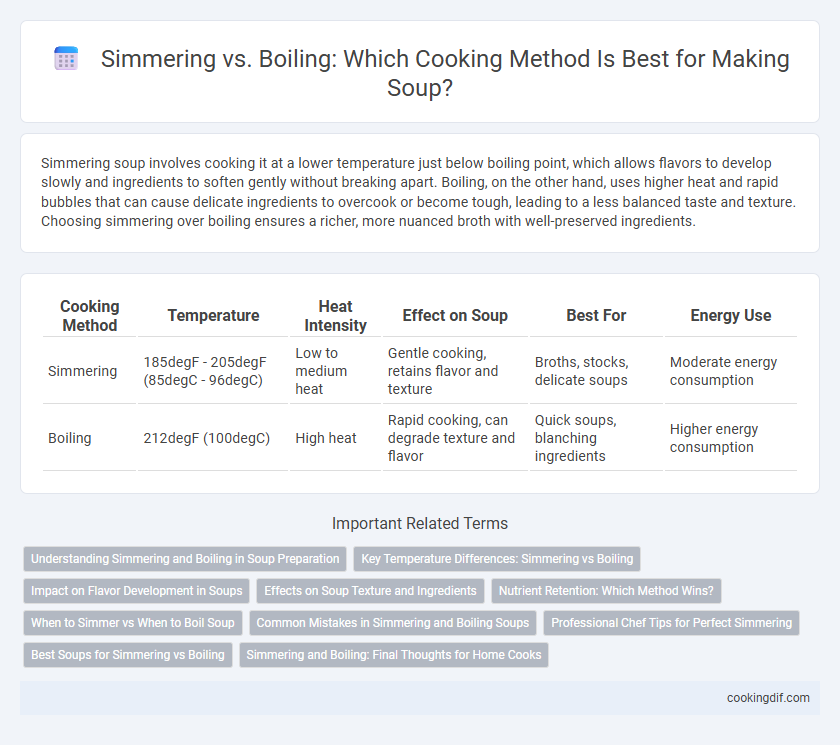Simmering soup involves cooking it at a lower temperature just below boiling point, which allows flavors to develop slowly and ingredients to soften gently without breaking apart. Boiling, on the other hand, uses higher heat and rapid bubbles that can cause delicate ingredients to overcook or become tough, leading to a less balanced taste and texture. Choosing simmering over boiling ensures a richer, more nuanced broth with well-preserved ingredients.
Table of Comparison
| Cooking Method | Temperature | Heat Intensity | Effect on Soup | Best For | Energy Use |
|---|---|---|---|---|---|
| Simmering | 185degF - 205degF (85degC - 96degC) | Low to medium heat | Gentle cooking, retains flavor and texture | Broths, stocks, delicate soups | Moderate energy consumption |
| Boiling | 212degF (100degC) | High heat | Rapid cooking, can degrade texture and flavor | Quick soups, blanching ingredients | Higher energy consumption |
Understanding Simmering and Boiling in Soup Preparation
Simmering maintains a temperature just below boiling, around 185-205degF (85-96degC), allowing flavors to meld gently without breaking down delicate ingredients in soup. Boiling reaches 212degF (100degC), producing vigorous bubbles that can cause proteins to toughen and fats to separate, resulting in a less clear broth. Choosing simmering over boiling preserves the soup's texture and clarity, enhancing the depth of flavor and overall quality.
Key Temperature Differences: Simmering vs Boiling
Simmering soup occurs at temperatures between 185degF and 205degF (85degC to 96degC), allowing gentle cooking that preserves flavor and texture. Boiling reaches 212degF (100degC) and creates vigorous bubbles, which can break down delicate ingredients and cause cloudy broth. Maintaining simmering temperatures is ideal for developing rich, clear soup without overcooking components.
Impact on Flavor Development in Soups
Simmering allows flavors to meld gently, preserving the subtle aromas of herbs and vegetables while preventing bitterness caused by aggressive boiling. Boiling can break down delicate ingredients too quickly, resulting in a less complex taste and cloudy broth. Maintaining a steady simmer enhances the depth and clarity of soup flavors, making it the preferred technique for achieving a rich, balanced profile.
Effects on Soup Texture and Ingredients
Simmering soup at a gentle heat preserves the integrity of delicate ingredients, resulting in a richer, smoother texture and enhanced flavor melding. Boiling agitates the soup vigorously, which can break down vegetables and toughen proteins, leading to a cloudier broth and uneven texture. Maintaining a consistent simmer allows ingredients to cook evenly while retaining their shape and nutritional value.
Nutrient Retention: Which Method Wins?
Simmering soup at a lower temperature preserves more vitamins and minerals compared to boiling, which can cause nutrient loss due to high heat and vigorous agitation. Heat-sensitive nutrients like vitamin C and certain B vitamins degrade faster during boiling, reducing the soup's overall nutritional value. Opting for simmering enhances nutrient retention, ensuring a healthier, more nutrient-dense soup.
When to Simmer vs When to Boil Soup
Simmering is ideal for soups requiring gentle cooking to blend flavors without toughening ingredients, such as broths, stews, and delicate vegetables. Boiling is suited for quickly cooking hearty ingredients like beans or tougher cuts of meat, ensuring they soften efficiently. Use simmering when clarity and depth of flavor are essential, and boiling when speed and thorough cooking are the priority.
Common Mistakes in Simmering and Boiling Soups
Common mistakes in simmering soup include heating too quickly, causing boiling that breaks down ingredients and leads to cloudy broth. Over-boiling can cause proteins and vegetables to toughen, resulting in less flavorful and unevenly cooked soup. Maintaining a gentle simmer preserves texture and enhances flavor extraction from ingredients, delivering a balanced and clear soup.
Professional Chef Tips for Perfect Simmering
Professional chefs emphasize maintaining a gentle simmer at around 185-205degF (85-96degC) to extract deep flavors without breaking down delicate ingredients in soup. Using a heavy-bottomed pot ensures even heat distribution and prevents scorching, while occasional stirring helps develop a complex, balanced taste. Controlling the heat precisely avoids rapid boiling, which can cause cloudy broth and toughen vegetables or meats.
Best Soups for Simmering vs Boiling
Simmering gently cooks soups like chicken noodle and minestrone, preserving delicate flavors and tenderizing ingredients without breaking them apart, ideal for brothy and chunky recipes. Boiling rapidly heats soups such as chili and vegetable stew, intensifying flavors quickly but risking ingredient disintegration in more delicate soups. Choosing simmering or boiling depends on the soup's ingredient robustness and desired texture to achieve optimal taste and consistency.
Simmering and Boiling: Final Thoughts for Home Cooks
Simmering soup ensures flavors meld gently without overcooking ingredients, preserving texture and nutrients better than boiling. Boiling may cause tougher cuts of meat to become stringy and vegetables to lose their vibrant colors and nutrients. Home cooks benefit from simmering as a controlled, low-heat method that produces richer, more balanced soups with improved taste and consistency.
Simmering vs Boiling for soup cooking method Infographic

 cookingdif.com
cookingdif.com